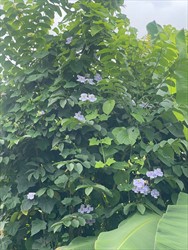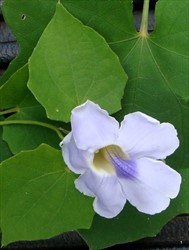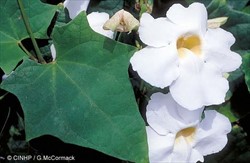Blue trumpet vine. It is also known as blue thunbergia, or Bengal trumpet.
Pacific Pests, Pathogens, Weeds & Pesticides - Online edition
Pacific Pests, Pathogens, Weeds & Pesticides
Blue trumpet vine (539)
Thunbergia grandiflora. It was previously known as Thunbergia laurifolia. It is a member of the Acanthaceae family.
Asia, Africa, North, South and Central America, the Caribbean, Europe (Portugal), Oceania. It is recorded from Australia, Federated States of Micronesia, Fiji, Guam, Nauru, New Caledonia, Palau, Samoa, Solomon Islands, and Vanuatu. It is native to India and tropical Africa.
A climbing vine introduced and cultivated in many countries as an ornamental, but which often becomes an aggressive invasive weed, blanketing native vegetation. It invades pastures, roadsides, banks of creeks and rivers, and its impenetrable stands make it a major threat to remnant areas of tropical forests.
Vines up to 15 m, producing large tubers (up to 70 kg) (Photo 1). Stems are square when young. Leaves, variable in shape and size (but often arrow-shaped), up to 15 cm long and 10 cm wide, opposite along stems, on stalks 4-12 cm long, with several, small, pointed outgrowth from the margins, especially towards the base (Photos 2-4). Flowers are on stalks, 4-5 cm long, pale blue, violet or mauve, trumpet-shaped, 3-8 cm long and 6-8 cm across, formed from five rounded petals, one larger than the others, each with a yellow or whitish throat (Photos 2-4). There are two leaf-like bracts at the base of each flower. Fruits are cone shaped, 3-5 cm long. Seeds are flat, up to 1 cm long, and are propelled from the fruit for several metres when it splits.
Spread over short distances is by seed. Over longer distances tubers, stems and roots are moved by humans, livestock, vehicles, and water. Blue trumpet vine has been introduced throughout the tropics and subtropics as an ornamental, and then it has escaped from cultivation, accounting for its worldwide distribution.
Thunbergia grandiflora is one of the most problematic invasive plants. It can cover 100% of the ground over several hectares, excluding all native plants. In Australia, for instance, it not only blankets native vegetation (often pulling down mature trees), but its large tubers are responsible for damaging riverbanks, paths, fences, and foundations.
Used extensively as an ornamental for gardens, often to cover fences. There is evidence of its use as a folk medicine in Asia, and as a green manure in Africa.
BIOSECURITY
The chances of introduction of blue trumpet vine are high as it is commonly used as an ornamental plant in the subtropics and tropics. Countries not yet infested should consider all likely pathways for entry and apply quarantine measures accordingly. Particular attention should be given to the fact that introductions as an ornamental may escape cultivation with ease. It is readily available on the Internet.
It is listed as an invasive species in Central and North America (Hawaii), the Caribbean, parts of Africa, and Pacific islands, including Fiji, French Polynesia, and Samoa. In Australia, it is a category 3 restricted invasive plant under the Biosecurity Act 2014. It must not be given away, sold, or released into the environment.
Thunbergia grandiflora is on the Global Invasive Species Database (2023) of information on alien and invasive species that negatively impact biodiversity, managed by the Invasive Species Specialist Group of the IUCN Species Survival Commission: (http://www.iucngisd.org/gisd/speciesname/Thunbergia+grandiflora).
BIOLOGICAL CONTROL
Not a method recommended for Thunbergia grandiflora.
CULTURAL CONTROL
Physical & Mechanical:
- Hand-pulling or digging out is possible only for isolated plants or small plantings. Established plants have extensive underground roots and tubers.
- ensure all stem fragments, roots and tubers are removed; collect and burn them, otherwise they may resprout if left on or in the soil.
- Do not use topsoil from places where blue trumpet vine has been growing. Movement of soil from such places is a major method of spread of this weed.
In Queensland, Australia, application of herbicide has been found to be the only option. The chemical imazapyr is registered for the control of Thunbergia grandiflora. It is applied either: (i) as a spray to run off and preferably at times of the year when the plant is actively growing; or (ii) by the cut stem/tuber technique - make a 'V'- shaped cut in the stem or tuber and apply the herbicide into the cut.
Note, consult the herbicide label for the amounts to use. One application may not be sufficient, so monitor the plants and follow-up if needed.
____________________
When using a pesticide, always wear protective clothing and follow the instructions on the product label, such as dosage, timing of application, and pre-harvest interval. Recommendations will vary with the crop and system of cultivation. Expert advice on the most appropriate herbicides to use should always be sought from local agricultural authorities.
AUTHOR Grahame Jackson & Konrad Englberger
Information from Blue thunbergia Thunbergia grandiflora (syn. Thunbergia laurifolia) (2020) The State of Queensland, Department of Agriculture and Fisheries.(https://www.daf.qld.gov.au/__data/assets/pdf_file/0007/77326/thunbergia.pdf); and Blue thunbergia (2021) Business Queensland, Queensland Government. (https://weeds.brisbane.qld.gov.au/weeds/blue-thunbergia); and Thunbergia grandiflora (2023) Global Invasive Species Database. (http://www.iucngisd.org/gisd/speciesname/Thunbergia+grandiflora). and Blue thunbergia Thunbergia grandiflora (Undated) Weed identification tool. Brisbane City Council. (https://weeds.brisbane.qld.gov.au/weeds/blue-thunbergia); and from CABI (2012) Thunbergia grandiflora (Bengal trumpet). Crop Protection Compendium. (https://www.cabidigitallibrary.org/doi/10.1079/cabicompendium.117524). Photos 1-3 Konrad Englberger, Pohnpei, Federated States of Micronesia. Photo 4 Gerald McCormack, Cook Islands Biodiversity Database, Version 2007.2. Cook Islands Natural Heritage Trust, Rarotonga. (http://cookislands.bishopmuseum.org/).
Produced with support from the Australian Centre for International Agricultural Research under project HORT/2016/185: Responding to emerging pest and disease threats to horticulture in the Pacific islands, implemented by the University of Queensland and the Secretariat of the Pacific Community.







